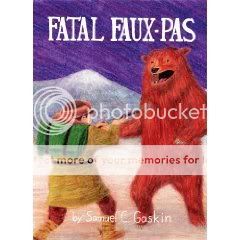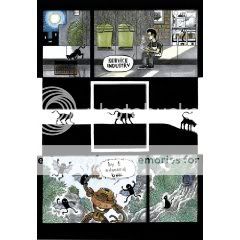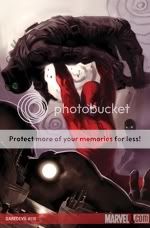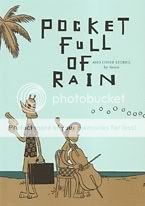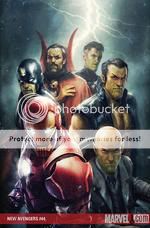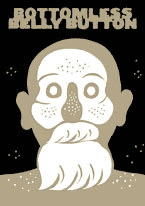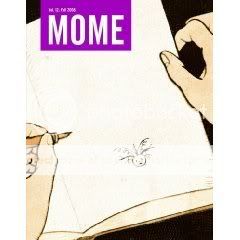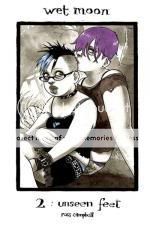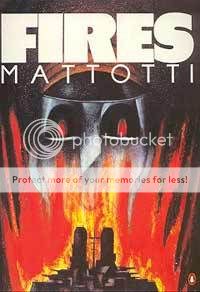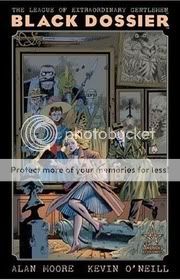Posts Tagged ‘Comics Time’
Comics Time: Fatal Faux-Pas
September 29, 2008Fatal Faux-Pas
Samuel C. Gaskin, writer/artist
Secret Acres, 2008
96 pages
$10
I’ve got some friends who aren’t artists per se but love comics and are pretty sharp thinkers about how they work, and when they draw, this collection is what they draw like. In that way this is a fun read, as experiencing the enthusiasm of someone who’s doing comics not because of a killer set of innate chops but for love of the game is a fun thing to do. Well, at least it is in this case, because unlike the usual soul-destroying genre efforts and aimless self-indulgent autobio/humor things produced with the same impetus, this book is actually drawing from a pretty strong set of influences and is being harnessed by a guy who learned enough tricks about pacing from big-time altcomix people to use some of them himself.
That said, it really is just a collection of small, weirdish doodles and (mostly) half-funny-haha half-funny-strange strips. It’s not going to light the world on fire, though to be fair, obviously it’s not meant to. There’s a thing about cavemen that looks a little like Tom Gauld, a Saved by the Bell parody that looks a little like Esther Pearl Watson, there are a couple of little-weird-dude strips who look a little like Marc Bell, there’s a collage-image-type thing that looks a little like Paper Rad, there’s a John Porcellino homage that looks a lot like, you guessed it, Hal Foster. (Haha, no, John P.) There are a some longer, not-quite-funny things involving Harry Potter summoning Black Sabbath and a Hollywood hack director trying to ape Werner Herzog by deliberately acting like a crazy person on set. If all this stuff were by one of my friends I’d be like “Hell yeah, awesome!”, and even as it stands it makes me want to my hand at doodling some stuff, but that’s really not the greatest idea, is it. Still, it’s nice to be made to feel that way once in a while, don’t you think?
Comics Time: Service Industry
September 26, 2008Service Industry
T. Edward Bak, writer/artist
Bodega Distribution, 2007
30 pages
$9.95 (don’t worry, they’re big pages)
In my experience most autobiographical comics come from a place of, if not quite acceptance, than at least understanding. To be really pat about it, they seem to be an artist’s way of making sense of their own lives. Not so with T. Edward Bak’s Service Industry, which feels less like a reflection upon events and more like a wounded, panicked wail about them. The book’s structure–alternating with little warning between present-day ruminations, autobio flashbacks, and dreamlike flights of fancy shot through with atheistic metaphysics and brutal self-deprecation–suggests nothing so much as a man coming apart at the seams. The Bak presented here has been driven to the brink by being a thinking man who’s realized he can’t think himself out of the problems that demand his mental and emotional attention. He’s aware of the pointlessness of his menial job as a dishwasher in the increasingly stratified American class system, which in its way he blames for a tormented family history that includes his mother’s abandonment of his infant sister, his military father’s abandonment of the whole family (to become a minister), and his own abandonment of his ethnic heritage–but he feels incapable of doing anything about any of it. Certainly he rejects the potential of his comics to make a bit of difference, and in that light his draftsmanship and line–neither as sophisticated as his concepts or layouts, but both adequate–actually reinforce his point through their lack of showiness. (It’s easier to bellyfeel that Bak feels like it’s all a waste of time than it would be if he could draw like Chris Ware.) It’s this conflict between awareness and agency that fuels Service Industry‘s ever-increasing sense of desperation, and possibly even breakdown. In that way it’s a frightening comic. You know how you reach a certain age and notice you’re not getting any happier, and instead of being romantic in a teenage-wasteland kind of way, the idea that you’ll be battling sadness for the rest of your life now fills you with abject horror?
Comics Time: New Engineering
September 24, 2008New Engineering
Yuichi Yokoyama, writer/artist
PictureBox, 2007
232 pages
$19.95
Copies of New Engineering should be automatically sent to any comics artist who draws action for a living, through the mail, courtesy of state or local authorities, in much the same way that Billy Joel’s Greatest Hits is issued to all Long Island residents when they reach age 10. It’s just something they’re going to need if they want to keep up.
Unfettered by plot or character considerations as such, Yokoyama’s comics are pure action: combat and construction most memorably, but also travel and some sort of bizarre approximation of automation. With a no-nonsense line Yokoyama follows objects in motion, allowing layout within each panel and on each page to be dictated simply by the inherent length of each action beat rather than any kind of human or emotional component. The result is an always fresh, frequently thrilling approach to choreographing and staging the movement of physical bodies through space.
In battle comics like “Book” and “Model Room,” Yokoyama frequently captures his combatants and their weaponry at the vertex of their movement–that moment at the top of the roller coaster where you’re about to shift from tilting forward to tilting backward. The view constantly shifts to show us the most exciting possible vantage point, allowing thrown objects (or people!) to guide us to a new vantage point within the space. (Think of that bit in The Fellowship of the Ring where we travel across the chasm with Legolas’s arrow and switch our POV when it hits its target, so we now are seeing all the physical space described by the arrow’s path.)
Yokoyama’s “Engineering” comics, wild onslaughts of strange, seemingly purposeless terraforming of featureless natural landscapes into pre-fab mountains, rivers, forests and so on, do just as much to call our attention to how things move. I particularly like the contrast between the great rolls of astroturf that unfurl off into the distance and the enormous boulders that are dropped from above and thud into their destinations as resolutely as possible. The human workers in these comics are also dynamos, frantically running around performing their tasks and screaming all the way. (You’ll have to check the footnotes for the sound effects to pick up on that, though. Yokoyama’s art is inseparable from his sound effects, leaving his translators with the unenviable task of figuring out how to tell us what the hell is going on. They opt for a footnote approach so as not to clutter up the art, which I understand, but as always with manga I think a discrete English subtitle beneath each sound cue would go a long way toward legibility.)
I think it’s that fast pace, and the screaming, that give us the key to what’s going on here. (Or maybe not–the interview and notes included in the supplemental material don’t reveal a lot regarding his philosophical intentions, which to be honest is fine with me.) Everything in New Engineering happenshappenshappens and then ENDS, often in the most nonsensical ways–the cataclysmic “Engineering” series in particular tends to end with amusing anticlimaxes, like everyone rushing into the big boulder-thing they just built only to stand still in a small square room. It’s a rush to do big out of control things for little discernible purpose, and certainly no regard for their ultimate effects. It all feels eerily familiar.
Comics Time: Captain Britian & MI:13 #5
September 22, 2008Captain Britain and MI:13 #5
Paul Cornell, writer
Pat Oliffe, artist
Marvel, September 2008
32 pages
$2.99
Hahahahahahaha! What a last page! I can’t remember the last time I was that tickled and delighted by the end of a superhero series’ monthly installment. Heck, the last time I laughed that hard at a comic, I was reading Tales Designed to Thrizzle. But this is a different kind of laugh, the kind you get from watching Doomsday or something like that–ah, I don’t want to spoil it. You should read it for yourself.
Which I suppose is what I want to say about the whole comic. Captain Britain & MI:13 has had an unusual life so far. It’s part of Marvel’s recent strategy of launching new ongoing series with story arcs that tie in with the event du jour. In this case, Captain Britain, the Black Knight, Spitfire, Pete Wisdom, John the Skrull and some other British heroes repelled a Skrull invasion of the U.K. designed to capture the magic of Avalon to use against humankind. It was a clever enough raison d’etre for a tie-in, reminiscent of the way The Incredible Hercules had a Secret Invasion tie-in arc about gods from Marvel’s various pantheons waging war against the Skrull’s own deities, but since this was the first glimpse anyone had at the series it was tough to figure out how it would feel when removed from that event-comic “everybody against overwhelming evil for all the marbles” feel. I figured I’d take a look at this issue, the first one outside the SI umbrella, think to myself “eh, well done for what it is, but not for me,” and be on my way.
Chances are I’ll be sticking around. Writer Paul Cornell is taking a pre-existing, already appealing batch of characters and concepts and putting them together in a solid team concept: a melange of gaudy, famous superheroes, secret Captain America-style black ops guys, and enthusiastic civilian-adventurers are employed to keep the United Kingdom safe from evil supernatural entities freed during the Skrull invasion. Now that I think of it, it’s a bit like the full-of-promise Breakout arc of New Avengers, where a varied group of superheroes formed an ad hoc team dedicated to tracking down supercriminals freed during a raid on a supermax prison, and finding whoever was responsible for the breakout. That very quickly got sidetracked by storyarcs explaining who each of the more obscure team members actually were, but it was a swell idea, and hopefully here we’ll see it put into practice.
But more than just the nuts and bolts basics of the superconcepts involved (which I’ll admit are a big part of it–heck, a part of me thought that even if it was a bad book I’d stick around just to see if and when Union Jack joined the team), Cornell has imbued it with lively, entertaining dialogue, particularly from the sensational character find of the comic, Faisa Hussain. This accidental superheroine–a motormouthed, starstruck, Excalibur-wielding, (oh yeah) Muslim doctor who gained healing powers from a Skrull contraption–is just a cool code name away from being the most unique, and well-realized, new Marvel hero since the Runaways. (Although I guess none of the Runaways’ codenames ever really stuck. Oh well.) It’s the kind of writing capable of making the arrival of Blade (British-born, you know) actually seem like a big honking deal. Which leads us to that last page…hahahahahahahahaha!
Earlier in the ’00s, many of the best superhero comics self-consciously dealt with self-conscious second-string superheroes and supervillains. While the marquee characters were still tied up with fairly old-school superheroics, writers from Brian Michael Bendis to Peter Milligan examined what it might be like to be an extraordinary being who, for whatever reason, wasn’t seen as being all that extraordinary by the people of their world. It was an extremely meta idea–after all, it was real-world fans who decided that Spider-Man was a superstar, and the fiction just twisted to reflect that. Eventually it became a reflexive tic of writers to have any characters who weren’t members of the Justice League, the Avengers, or the Uncanny X-Men describe themselves as D-listers, and whatever point was being made about celebrity or identity was lost. These days, the most rewarding superhero titles that star characters who aren’t on the short list for movie treatment–The Incredible Hercules, The Immortal Iron Fist, Agents of Atlas, Captain Britain–don’t comment on that fact, they take advantage of it, using these characters’ remove from the Big Events and megateams to carve out their own way of doing superhero comics: incorporating other genres, expanding their mythologies, giving the characters a different goal, adopting a different tone than the current “Lost riff and/or summer popcorn movie” options have to offer. As seen here, it’s an engaging, successful strategy.
Comics Time: Daredevil #110
September 19, 2008Daredevil #110
Ed Brubaker & Greg Rucka, writers
Michael Lark & Stefano Gaudiano, artists
Marvel, September 2008
32 pages
$2.99
Since I last took a Comics Time look at this series, it’s remained the least attention-getting of Ed Brubaker’s Marvel titles, lacking the sales of Uncanny X-Men and Captain America and the buzz of Immortal Iron Fist and Criminal. In that time it’s become a Gotham Central reunion, too, with Greg Rucka joining the Brubaker/Lark/Gaudiano team. And it’s taken a big step away from constantly crescendoing turmoil for the life of its main character, which has been the series’ M.O. since Brian Michael Bendis and Alex Maleev took it over, if not since Frank Miller established the template. What you’ve got instead feels more like a Law & Order: Special Victims Unit, as Daredevil and his private investigator friend Dakota North pull a Stabler & Benson and try to figure out why the FBI is covering up the murder of children while framing a former super-thug. Turns out it’s a Lucky Luciano-style deal with one of Marvel’s stock gangland figures to keep an eye on the docks he runs, ensuring that no Latverian or Madripoorian terrorists sneak in.
In other words it’s nothing you haven’t seen before…yet there’s something enormously satisfying about that. As much fun as it can be to follow superheroes through a series of interconnected, constantly escalating crises, it can also be pretty exhausting. Stepping back from shadowy masterminds manipulating Matt Murdock’s life for pleasure and profit and simply having the guy break the fingers of crooked Feds to spring a character named Big Ben from jail has its own rewards. Meanwhile, if we must get macro about it, finally letting DD settle in to a status quo, however briefly, can only enhance the impact of his next world-turned-upside-down arc. God only knows who or what “Lady Bullseye” is and what or who she’ll be doing next issue, but I’m happy to have a potboiler breather before finding out.
Comics Time: Pocket Full of Rain and Other Stories
September 17, 2008Pocket Full of Rain and Other Stories
Jason, writer/artist
Fantagraphics, 2008
160 pages
$19.99
Surely one of the great miracles of living in this, the New Golden Age of Comics, is that one can own in the neighborhood of a dozen different Jason books, in English. Perhaps the single strongest page in this entire collection is the final one, where the covers of nine of the great Scandinavian cartoonist’s other available works are arranged in a Watchmen-style grid. It makes you want to declare victory on behalf of comics and go home. Mission accomplished!
In the early days of Jason’s translation and introduction into the English-speaking altcomix world, I remember hearing complaints about how Fantagraphics was presenting only one side of a very multifaceted artist–the grim, silent side. Perhaps that was true at the time, but in setting up such an austere (and, lest we forget, extraordinarily impressive) foundation, Fanta only served to heighten the impact of each new release as it strayed into the unexplored territory of genre–comedy, horror, thrillers, science fiction, and more, each with Jason’s trademark ruminative, fatalistic edge.
Pocket Full of Rain represents the apotheosis of this trend, dipping into the artist’s rich back catalog to dredge up works that expand the boundaries of what constitutes a “Jason comic” not only narratively but artistically. Showcasing a variety of early art styles–realism, funnypages cartooniness, altcomix weirdness–outside of his usual anthropomorphism, it’s dazzling in how conclusive an argument it makes that Jason could have gone in any of those directions and been nearly as successful as he is today. The title story, an existential thriller in the mode of Why Are You Doing This? only with humans (and the occasional alien) in lieu of funny animals, sort of makes me wish I could dip into an alternate universe where Jason’s career doing Gilbert Hernandez-style magic-realist crime stories using Adrian Tomine-like figurework continues unabated. (The way he plays with the passage of time, metonymizing scenes into single panels, is particularly reminiscent of Los Bros’ skills in that area.) A handful of surreal stories about death toward the end of the collection reveal an artist who’s equally at home actually doing horror as he is riffing on it in books like The Living and the Dead. A sampling of gag strips involving a prisoner, a cactus, a ghost and other seemingly randomly selected images plucked from Jason’s subconscious might have blossomed into a hit webcomic in a different era. Yet despite dating back as long as 15 years ago, it’s all of a piece with Jason’s familiar and haunting obsession with the capricious nature of life, as represented by sudden violence, the non sequitur intrusion of pop culture icons and tropes, the random collection of moments that taken together constitute love or its loss. Either as an introduction to Jason’s work or a reward for those who’ve followed it all along, this book’s a gem.
Comics Time: New Avengers #44
September 15, 2008New Avengers #44
Brian Michael Bendis, writer
Billy Tan, artist
Marvel, August 2008
32 pages
$2.99
I’ve been following Marvel’s Secret Invasion event somewhat with the half-hearted interest of someone who mainly wants to know what went wrong. The primary miniseries going under that title has seen six issues come and go, during which time virtually nothing has actually happened that can’t be described with the sentence “The Skrulls invade, but not hard enough.” Nick Fury and His Howling Characters No One Cares About have been battling the Skrulls’ Mighty Marvel Mash-Ups in New York City for what seems like three years, Avengers both New and Mighty gathered in the Savage Land for an inconsequential fight with an entire shipful of head-fake superhero impostors, Reed Richards got captured but now he’s free with his de-Skrulling gun that he made on the way back from Outer Space, Thor broke free from J. Michael Straczynski, and Bucky dropped in from a better comic. There you have it! It’s sort of the apotheosis of problematic Brian Bendis event comics, with lots of people and lots of people standing around and sounding kind of the same and kind of out of character, a lot of things happening but none of it really mattering, and in general all of it being far less successful than his more focused, solo-character-based superhero work, which treats the superhero idiom like the world’s strangest psychological coping mechanism and/or mental breakdown.
The real Secret Invasion action, in terms of enjoyable comics, has mostly come in the primary tie-ins, New Avengers and Mighty Avengers. This particular issue shows Bendis doing what he does best–“going there.” I’ll tell anyone who’ll listen that when big-deal villains show up, they should always majorly fuck up the lives of the heroes they fight, every time. It should be a rule. Granted, the Skrulls we see at work here are doing what they’re doing to lab-grown clones of Reed Richards so as to probe his mind for secrets they need for their Invasion to be successful–it’s not Richards himself–but man oh man, do they ever show how far they’re willing to go in service of their plans. Instead of standing around and talking like the world’s most violent Scientologists, or dressing up like random assemblages of other Marvel characters and shooting Human Torch fire or Cyclops lasers outside the borders of their double-page spread, they’re systematically creating human life only to torture and destroy it. Now that’s the kind of villainy I can get behind! Take it together with the other issues in these ongoing series, which tend to focus on “what’s up with So-and-So and how did the Skrulls get to him/not get to him” questions with precision, perverse imagination, and unsparing ugliness, and you have to wonder if some of this material couldn’t have been present in the main mini. If you’d shoved aside all the explosions and summary executions, you could have made room for the serious-business character crises that made Bendis the superhero writer to read in the early part of this decade, and still make Powers and Ultimate Spider-Man among my favorite genre titles.
Comics Time: Bottomless Bellybutton
September 12, 2008Bottomless Bellybutton
Dash Shaw, writer/artist
Fantagraphics, 2008
720 pages
$29.99
I finally got around to reading this Blankets-sized graphic novel over the past weekend. (Doing most of your reading on the commuter railroad disincentivizes taking a crack at really big books. Sorry, Bone. What is it with gigantic graphic novels that begin with the letter “B,” anyway?) It has more in common with Blankets than simply the initial and the size. They’re both works of great ambition from young authors–statements as much as stories–that tackle love, family, and the conflict between the two. They’re also both very, very successful.
The story takes place over the course of an awkward weekend-or-so at the home of the Loony family. The parents of adult children Dennis, Claire, and Peter have summoned their kids and their respective families or lack thereof to inform them of their impending divorce, after forty years of marriage. The set-up itself contains a rich vein to mine; as someone whose parents split up when I was an adult, I’ve never seen that uniquely pleasant situation this convincingly depicted, as once-intimate and effortless family dinners become merely cordial, well-worn anecdotes take on the feel of elegies, and being forced to think of your parents as full-fledged sexual, emotional, and psychological beings whose dreams have in some major way not ben fulfilled takes its toll.
Of course this could all be the territory of standard literary fiction, but to that sturdy framework Shaw harnesses any number of narrative digressions and artistic flights of fancy. A prologue section conveys its general point about the many facets of “family” and its specific expository information about the Loonys in the abstracted fashion of Shaw’s short comics. The book’s only nod to Shaw’s more surface-weird work–drawing youngest son, introverted loser Peter, as an anthropomorphized frog–is basically a multi-hundred-page set-up for a dramatic visual punchline that works so well it literally made me gasp. Meanwhile, each family member is given memorable mini-stories and scenes to play out, from Peter’s meet-cute with local beach bunny Kat to Claire’s drunken night out on the town with Dennis’s wife Aki to Claire’s daughter Jill’s disastrous rendezvous with a friend’s hilariously sleazy soon-to-be-ex-boyfriend (it’s complicated). This also means that Bottomless Bellybutton is several different kinds of comics at once; Peter’s story, for example, is at varying times a romance, a “my first time” erotic work, (briefly) a Christopher Guest-like send-up of indie filmmaking, and in one pulse-pounding sequence toward the end, something approaching Hitchcockian suspense. Yet the book never feels scattershot or random–it all quietly reinforces Shaw’s point that family means many different things to each of the many different people inside that unit, sometimes different things at different times and sometimes different things at once.
Perhaps the best illustration of this concept is the story of Dennis, the beloved eldest child. He takes his parents’ divorce much harder than Claire (herself a divorcée) or Peter (numbed to it by his distant relationship with a father who barely conceals his lack of feeling toward him, not to mention plenty of beer and weed), and begins a pretty literal quest to find the “reason” for the divorce, thereby becoming able to prevent it. This ends up involving secret passages, X-marks-the-spot maps, and notes between his parents’ younger selves, written in elaborate codes. As Dennis grows more and more insistent and angry about the divorce, his conviction that it can be “solved” like a Lost episode mounts as well, with Shaw playfully reinforcing this sense in the reader through those parlor-game clues and boy’s-adventure tropes–and also, though who knows if this is deliberate, making Dennis an insufferable Flat-Earther straight out of a Stephen King story. By the time Dennis’s quest ends in a heatstroke-induced “revelation” that turns out to be anything but the answer he sought, it’s clear that searching for any such answer to why life works the way it does is a mug’s game. That’s not to say that any of the other coping mechanisms adopted by the characters are superior–simply that rambling off into your own directions stands just as much of a chance at finding you what you want.
In pitching Bottomless Bellybutton to some friends who aren’t big alternative comics readers but who recently read and enjoyed Blankets, I said that the biggest difference between the two is the lack of Craig Thompson’s surface-pretty art. Shaw’s, by contrast, is deliberately uglified, particularly with those nothing-else-like-’em character designs. But I added that it’s an ugly that’s easily followed, and more to the point, easily understood. Both Blankets and Bottomless Bellybutton are about what happens when the idealized rapture of romance fades, but Bottomless takes place almost solely after the fade-out has already taken place. In this fallen world, Thompson’s vistas of snow and mandalas wouldn’t make a lot of sense. And while we do see one romance blossom, Shaw is intent on milking the tension between idealization and reality, starlit swims on the beach and premature ejaculation if you will. Impressive in the power of its gestalt, able to make judgments without seeming judgmental, and powerfully moving on more than one occasion, it’s a mature work from a young artist who with it comes fully into his own, and a deeply pleasurable, and rewarding, read.
Comics Time: Don’t Go Where I Can’t Follow
September 10, 2008Don’t Go Where I Can’t Follow
Anders Nilsen, writer/artist
with Cheryl Weaver, writer/artist
Drawn & Quarterly, 2006
86 pages
$14.95
This book beggars review. It’s an account of the great young cartoonist Anders Nilsen’s relationship with his fiancee Cheryl Weaver, through a series of varyingly told vignettes about the trips they took together or apart. Postcards they sent to each other are reproduced; a long letter from Nilsen to his little sister recounting a disastrous camping trip the couple took is printed in its handwritten entirety; there’s a three-page interlude about the couple getting stranded in a New Jersey parking lot on Christmas and, one infers, getting engaged shortly thereafter; there’s a photo essay about their trip to the Angouleme festival in France and a humor comic about their ill-fated first attempt to get there. Then we discover from Nilsen’s illustrated journal that Cheryl has been diagnosed with cancer, and the true meaning of the book’s metaphorical title, cribbed from J.R.R. Tolkien, becomes all too apparent. The comic that concludes the volume, perhaps the loveliest Nilsen has ever drawn, offers the final proof that the titular request has been met in the heartbreaking negative.
On the strictly technical side of things, Nilsen is one of his generation’s finest cartoonists, so part of what is so impressive about the book is how much of his comics’ pointillist emotional power comes through even via mostly non-comics media. By selecting a rigid parameter for the material, “stories about problematic travel experiences” (a theme he reveals in an afterword to have planned to develop even prior to Cheryl’s illness and death), Nilsen paradoxically conveys a sense of the totality of the couple’s relationship: thoughtful, humorous, shot through with both the thrill of adventure and discovery and the longing for the comforts of home, and one another. While Nilsen’s companion Ignatz series The End deals more in the gargantuan, even frightening feeling of grief and desperation engendered by having his and Cheryl’s life together suddenly yanked away, Don’t Go Where I Can’t Follow‘s mood is gentler–more focused on love and how it changes when the loved one is gone–but no less profoundly moving.
Personally, the way I deal with death is to focus on the fact that the life I shared with that person was a good one, a happy one, and that while it is now over, that goodness and happiness remains in my memory. But what happens when that shared life was, by any reasonable standard, far too brief? What to do then? I don’t know. Recent events have forced me to confront this question and I still don’t know. Reading this book has helped, though, and I hope you’ll forgive me if really all I have to say about it is “thank you.”
Comics Time: Mome Vol. 12: Fall 2008
September 8, 2008Mome Vol. 12: Fall 2008
Kaela Graham, Sophie Crumb, Nate Neal, Ray Fenwick, Olivier Schrauwen, Dash Shaw, Tom Kaczynski, Al Columbia, Jon Vermilyea, Derek Van Gieson, Killoffer, Sara Edward-Corbett, David B., Paul Hornschemeier, writers/artists
Eric Reynolds and Gary Groth, editors
Fantagraphics, August 2008
120 pages
$14.99
I’m not a big underground comics person, particularly today’s derivatives thereof. Too much of it feels like schtick to me: using “th’ ” instead of “the,” bigfoot characters smiling and waving at you and saying “hiya!”, funny animals fuckin’…I dunno, maybe this is how people who are sick of superheroes feel about capes and masks and punching–that it’s just going through the motions while not really saying anything about anything. It’s mostly not for me, though there are those who can make it work by blowing it out into the ionosphere of savagery (Rory Hayes) or through trailblazing and raw, restless chops (Crumb). Its imitators have an even tougher go of it with me–there aren’t a lot of Marc Bells out there, you know?
Last time out with Mome, I thought I was starting to detect and undergroundward drift, and the recent announcement that Gilbert Shelton seemed to confirm that suspicion. So I was all frowny-faced when I read the first comics contribution to this issue, from Nate Neal, “Whadda grade ‘A’ maroon I been! All that pissin’ and moanin’ I do about the world goin’ to shit…” says title character Tender Henderson. It’s enough to send you screaming for your Big Brother and the Holding Company record. But suddenly Neal shifts gears to a finely observed relationship comic, and even if you’ve seen this sort of thing before, we’re clearly back in the far less hammy, frequently more rewarding territory of contemporary artcomix.
That’s where I’d prefer Mome to stay, and for the most part that’s where it is here. For the first time in a while there are a number of comics included that fail to make much of an impression one way or another, but the winners are real doozies. David B. contributes yet another rhapsodic blend of history and fantasy with his tale of sex, violence, and religious zealotry “The Drum Who Fell in Love.” Olivier Schrauwen, Al Columbia, and Dash Shaw all discomfited me mightily with their astute use of silent, nightmarish strangeness. Kaczynski is really on a roll with his examinations of modern life’s nuisances-cum-perils, focusing this time on the pervasiveness of noise. Killoffer and Jon Vermilyea each serve up a different blend of gross-out humor and disturbing violence, both capping them off with killer, laugh-out-loud final panels. And let’s be honest with ourselves, any place you can get new work from David B. and Killoffer between one set of covers is the kind of place you want to be.
Comics Time: Wet Moon Book 2: Unseen Feet
September 5, 2008Wet Moon Book 2: Unseen Feet
Ross Campbell, writer/artist
Oni Press, June 2006
180 pages
$14.99
College is the time in everyone’s life when maximum personal freedom meets minimum personal responsibility. Classes and grades notwithstanding, there’s really nothing to stop you from doing pretty much whatever you want, whenever you want, in a parentless, highly sexed world where you are generally rewarded for following your bliss. I mean, at least this was how it was when you were a film studies major. It also seems to be how it is for the art students who populate Wet Moon, Ross Campbell’s languid goth soap opera. As is the case with those heady times before you’ve picked a major, or perhaps toward the end of your four years when you’ve basically completed all your requirements and have maybe four hours of classes every seven days, the kids in Wet Moon seem to neither know nor care where they’re going, simply soaking in the atmosphere of aimlessness. I can’t remember the last time I read a comic this visually (and aurally–the dialogue is spot-on) ambitious while having so little an idea of where that ambition was eventually going to take me. I don’t know how you’d feel about it, but I’m loving the experience. For one thing, it allows Campbell’s art to shine almost as an end in itself. It’s not just that his line is lovely or that his character designs are each unique and memorable or that his characters are basically all super-sexy in this delightfully slatternly way, though all these things are true; he also makes very smart choices in terms of choreography, body language, and pacing that really stick. When lead character Chloe accidentally mispronounces a pair of words in the middle of an argument, the look of self-irritation on her face is pricelessly accurate. There’s a great sex scene where the interplay of insecurity and self-confidence among young people is conveyed deftly and appealingly, but Campbell can also deflate his characters’ romantic presentations, as when he transforms Chloe’s memory of getting dumped by her beautiful ex-boyfriend Vincent into an over-the-top parody of goth sentimentality. And then there are random-ass scenes like some sort of reverie/dream sequence/I don’t know what involving a character drinking orange juice out of the carton, wandering into the street, and rolling one eye up into her head. What a weird, addictive series this is.
Comics Time: Clive Barker’s The Thief of Always
September 3, 2008Clive Barker’s The Thief of Always
Kris Oprisko, writer
Gabriel Hernandez, artist
adapted from the novel The Thief of Always by Clive Barker
IDW, 2005
144 pages
$19.99
Given the standard weakness of comics adaptations of non-City of Glass prose material and the standard cheesiness of American horror-comic art, any project that entails adapting a prose horror novel would normally already have two strikes against it. But Clive Barker has gotten lucky on that score a few times during his career, from the impressively atmospheric Books of Blood-based anthology series Tapping the Vein back in the day to this little number based on Barker’s first all-ages book. While you can see the rough edges in the edits quite frequently–most notably during the beginning and ending, which are rushed enough to feel like they happen how they do because they must, not because that’s what springs from the events that befall the characters and emotions they experience as those events take place–it’s a surprisingly evocative, beautifully illustrated little graphic novel about a childhood lost.
The story concerns a schoolkid named Harvey Swick who, bored to tears by a dreary February, is approached by a magical being with a beyond-ear-to-ear grin, named Rictus. (Already a good sign, right?) Rictus offers Harvey a vacation to a place called the Holiday House, whose mysterious proprietor Mister Hood offers “special” children an eternity of carefree carousing, with each day in the place comprising all four seasons of the year. (Every morning is springtime, while it’s Halloween every evening and Christmas every night.) Needless to say things aren’t what they seem, and before long Harvey and the friends he makes at Holiday House try to escape this lotus-eating interval to return to the outside world, which turns out to be tougher than it looks.
While the book tends now to be compared to Harry Potter, it has a lot more in common with other stories of childhood voyage and return to a dangerous land of fantasy: Oz, Wonderland, Never-Never Land, and Barker’s own Abarat. The idea of the haunted house–since that’s obviously what we’re dealing with–also hits notes resonant with everything from Hansel & Gretel to The Shining, not to mention Candyman director Bernard Rose’s Paperhouse, a more-or-less contemporary product of the British dark fantasy scene, iirc. Aside from the obviously truncated start and finish to the story, Oprisko does a solid job of preserving as much of Barker’s weird whimsy as possible, making sure to include moments that stand out from the fairy-tale norm–Harvey’s phone calls home to his parents to make sure they’re okay with his vacation, for example.
The real star of the adaptation, though, is Gabriel Hernandez and his absolutely lovely art. It appears to have been done in pencil, then given a soft bath in muted color washes by Sulaco Studios. The contrast between Hernandez’s off-kilter, frequently angular character designs and Sulaco’s gauzy palette is pretty much perfect for Barker’s kids’ fantasy work, which itself introduces elements of the horrific into a storytelling mode we’re frequently quite cozy with. Hernandez is as attentive to detail as he is to design–for example, quietly filling the Holiday House with everything a boy could wish for, from suits of armor to Egyptian sarcophagi to preserved pterodactyls, despite this never being referred to in the dialogue. It’s the art that will keep me coming back to this one, and makes it worth at least a first look.
Comics Time: Fires
September 1, 2008Fires
Lorenzo Mattotti, writer/artist
Penguin, 1991
64 pages
I’ve had this book for a long long time, acquiring it through Sequential Swap because hey, Lorenzo Mattotti, right? One of the great comics artists in the world! But I’ve put off reading it for just as long because the great comics art inside it is, if I’m being honest, not for me. I don’t see people in Mattotti’s blocky, quasi-cubist painted figures, I see blocks. With its tactile layers of color covering every inch, I have a hard time finding an “in” to any given panel. My eye just bounces right off the surface.
The funny thing is that the story almost overcomes this. It stars one Lieutenant Absinthe, an officer in the navy of a South American archipelagic country whose battleship is sent on a mission to investigate the mysterious island of Saint Agatha, where ships seem to go missing with alarming regularity. In an arc that should be familiar to fans of everything from The Lord of the Flies to Lost to The Shining, Absinthe–heh, here I was going to say “slowly” out of sheer force of habit, but it happens almost overnight–goes native, and ends up helping the supernatural (?) forces present on the island destroy his comrades. On the back cover, a blurb from Mattotti indicates that his inspiration was the films of Tarkovsky and Herzog and the hypnotic power of their environments; in essence, Mattotti’s project was to craft a story that does what his art fails to do with me, which is suck one in. He works so hard at it that he almost pulls it off–the story’s climax in particular is vividly done–and the countless similar stories you’ve read or seen do some of the work for him, but ultimately I keep running into that wall of visual information over and over again and finding no way to join Lieutenant Absinthe as he’s pulled in.
Comics Time: Brilliantly Ham-fisted
August 29, 2008Brilliantly Ham-fisted
Tom Neely, writer/artist
I Will Destroy You, July 2008
20 pages
$5
They can’t all be winners, but this collection of “19 comic strip poems” originally published on Tom Neely’s blog boasts some very strong work, including among them some of my favorite comics of the year. Constructed by juxtaposing a simple sentence against a four-panel strip’s worth of largely abstract imagery, these comics are a veritable catalogue of Neely’s visual preoccupations: Tall houses with crooked chimneys, Gottfredson-style white gloves, deep-black, viscous blots of ink, lone trees, holes, the severing of heads or hands. At times they’re used to strike a harrowing tone of confusion and despair–“Seething Rage” is a memorable portrait of a literally beaten man, while “House of Cards” plays off one of my personal favorite tropes for utter senselessness, roadkill. Given my own predilections it’s probably no surprise that the book’s more hopeful moments–“New,” touting the power of hope in the form of a newborn; “R.R.I.P.”, a declaration of ars gratia artis inspired by painter Robert Rauschenberg–leave me cold, leaning a little further toward the mushiness that is an occupational hazard of “comic poetry.” Still, “O.K.,” a full-color strip that overwhelms with the beauty of its palm-trees-at-sunset vista while the text celebrates the acceptance of a proposal, proves that Neely has the illustrative chops to give even his most (understandably!) sentimental inclinations real punch.
Comics Time: Your Disease Spread Quick
August 27, 2008Your Disease Spread Quick
Tom Neely, writer/artist
characters and dialogue inspired by the album (A) Senile Animal by the Melvins
Robotic Boot, Summer 2008
22 pages
$6
You don’t need to listen to the Melvins to appreciate Your Disease Spread Work as further evidence, as if any were needed after The Blot, that Tom Neely is working the most fruitful vein of horror-slash-artcomics since Al Columbia. Like Columbia, Neely’s work borrows stylistic elements from masterful old black-and-white kids’ cartoonists like Otto Mesmer and Floyd Gottfredson, then harnesses it to a unique vocabulary of monstrousness and murder. While Columbia tends toward intimate horror in the work of his I’ve seen, Neely’s best stuff is characterized by a tendency to scale upward and outward at breakneck speed, with threats suddenly emerging as colossal if not outright apocalyptic.
YDSQ addresses that tendency head-on, beginning and ending with words of woe from a doomsday prophesier with the head of a horse. In between we encounter decapitations, an infernal saloon populated with infamous tyrants, Neely’s trademark black-ink blots, a sequence reminiscent of that old 7-Up mascot Spot crossed with H.P. Lovecraft, the Big Bad Wolf, a ghoul, a thunderbird, a Fritz Lang-style robot bride, a mummified Baby Herman type, scenes of everyday depravity, and more. At no point does any of this arrive from a predictable direction or feel anything less than profoundly discomfiting. It adds up to a portrait of great unease with the direction of society, coupled with a gallows humor about it all (there’s a Hostess ad parody on the back cover to cleanse the palate). What it has to do with the Melvins I may never know, but it works as both an ad for the band and a statement completely independent of them.
Comics Time: Incanto
August 25, 2008Incanto
Frank Santoro, writer/artist
PictureBox Inc., 2006
44 pages
$5
I have no idea if this is an active reference point for him at all, but I can’t read Frank Santoro comics without thinking of the swirly, sensual, romantic rapture of a good shoegaze song. Both are (generally) more concerned with mood than with any kind of narrative–knowing, perhaps, that emotions can be stories in and of themselves. This particular comic reads a little like a dress rehearsal for the more rhapsodic moments of Santoro and Ben Jones’s teenage-riot series-cum-OGN Cold Heat. Joining his usual minimal line to an equally minimal layout (one or two panels per page), complemented by unbroken fields of blue, orange, and white color, Santoro “tells” the “story” of an emotionally epic romance in the language of metaphor–wild horses, mysterious combat, vampiric antagonists, deserts and mountains, blazing suns, parents that just don’t understand, desperate embraces, taking off a shirt, hands on bodies. Each of these sort of dissolves into the next in a fashion that enables you to make it all the way through the comic in under a minute, or flip back and forth and re-re-re-read like putting “Vapor Trail” on repeat. It’s slight, and not for everyone, but lovely for me. I want to connect with the emotions he’s conveying even though feeling them has become a distant memory for me.
Comics Time: Where Demented Wented: The Art and Comics of Rory Hayes
August 22, 2008Where Demented Wented: The Art and Comics of Rory Hayes
Rory Hayes, writer/artist
Dan Nadel and Glenn Bray, editors
Fantagraphics, August 2008
144 pages
$22.99
I do a lot of reading on a crowded Long Island Rail Road train into and out of New York City. Since I am still a polite, people-pleasing elementary school kid at heart, this made it impossible for me to sit back and enjoy the section of this book that reproduced Cunt Comics #1, you know? So what I ended up doing is skipping that stuff and reading everything else, saving the Cunt material for a time when it wouldn’t be inflicted on unsuspecting commuters. Stripped of that almost indescribably vulgar middle section, the work of the live-fast-die-young underground comix legend Rory Hayes as collected in Where Demented Wented comes across less like that of a knowing, Crumb-style provocateur–or a novelty-act modern primitive, for that matter–and more like that of a wild-eyed innocent who’s seen far too much. I guarantee you I’m the only person who’s going to make this comparison, but do you remember the scene from Stephen King’s science-fiction short story “The Jaunt” where (SPOILER WARNING FOR ANYONE WHO FALLS INTO THE PART OF THE VENN DIAGRAM WHERE “RORY HAYES READERS” AND “READERS INTERESTED IN THE SHORT STORIES OF STEPHEN KING BUT WHO HAVEN’T YET READ THEM” OVERLAP) the kid holds his breath when they dose him with anesthetic prior to teleportation, so he comes through the other side having been driven bugfuck insane by the infinity of time and space his mind experienced during his instantaneous travels? Sort of like that.
It doesn’t necessarily start that way. In the first, comparatively crudely drawn stories from Hayes’s Bogeyman Comics #1, Hayes crafts surprisingly deft and tightly paced homages to the macabre twist-ending horror stories of EC Comics. In addition to those ’50s classics, Hayes’s emphasis on decay recalls the weird work of Lovecraft and Bierce, while his inventive staging and attention to environment anticipates work by far more surface-sophisticated genre artists, from Josh Simmons’s House and Jessica Farm to Clive Barker’s “The Midnight Meat Train.” While the mood here is certainly one of impending doom, it is at least a doom that suggests through contrast the possibility of making it out alive. I can’t decide whether Hayes’s trademark teddy-bear protagonists–whose incongruity and iconicity serve to instantaneously (and rather amusingly) anchor even his most outlandish and savage stories to a dimly remembered time of childhood playfulness–make things seem more hopeful (innocence exists!) or less (innocence is destroyed!).
It seems as though when Hayes’s drug use became dominant enough to start finding its way into his work on an explicit level shortly thereafter, however, a switch flipped. Skip past the Cunt Comics interregnum as I did and all of a sudden you find a Hayes whose work is far more artistically refined–with an almost Drew Friedman-slick stippling effect at times–while his conceptual framework has expanded outward almost infinitely, to far more threatening effect. In between cynical semi-autobiographical accounts of tweaked-out excess and gross-out humor-ish strips with a bitter Country Joe “Whoopee! We’re all gonna die!” tone, Hayes’s protagonists are now more at risk from contact with eternity or the destruction of the entire world than they are from creatures locked behind cellar doors. Perhaps the most memorable of these later strips involves one of the teddy bears traveling to a dead world filled with abandoned towers and forgotten artifacts, its sole surviving inhabitant scrawling the enigmatic, haunting phrase “WE TRIED” on the ground, reducing the doomed explorer to tears. Seen in the light of material this powerful, Cunt‘s onslaught of castration, bodily fluids, and vaginas drawn as though the artist had hardly even a passing familiarity with the form seems like a necessary mental enema, a way of throwing off almost any kind of restraint self or society could impose so as to better access the frightening truth, if that’s what it is.
Towards the end of the book, during an essay of remembrance written by Rory’s brother Geoffrey, a short, early comic by Rory called “Lost at Sea” is discussed and reprinted at a reduced size. Based on an 8mm film Rory made, it features a teddy bear in a tiny boat, adrift in an enormous and storm-tossed sea. Finally, after a particularly frightening tempest, the bear finds himself and his boat safe on the sandy shore. The final image is simply of the bear’s footprints, leading away from the water back home. In a way, this collection is that trail of footprints.
Comics Time: Invincible Iron Man #1-4
August 20, 2008Invincible Iron Man #1-4
Matt Fraction, writer
Salvador Larroca, artist
Marvel, May-August 2008
32 pages each
$2.99 each
The problem with Iron Man in the wildly popular, not good Marvel event series Civil War wasn’t that he was wrong, but simply that he was written wrong. You may recall that the conflict between Iron Man and Captain America was driven by Iron Man’s desire to see all superheroes register with the government, an eminently sensible approach to human weapons of mass destruction no more outlandish than requiring official sanction for police departments and the Marines (or hell, student drivers and barbers). Unfortunately, it fell to the character to bear the metaphorical weight of warantless wiretapping, the abolition of habeas corpus, secret prisons, torture, and all the other actual excesses of the War on Terror. And so the writers of the event, particularly the main series’ Mark Millar and Amazing Spider-Man‘s J. Michael Straczynski, turned the character into an unlikeable, smarmy fascist bastard.
You’ll hear some people say this is perfectly appropriate for a character whose secret(ish) identity was a munitions expert who built his first suit of armor in order to kill his way out of an NVA prison–that he’s the military-industrial complex personified. Me? While I read Civil War in disbelief I was listening to Ghostface Killah’s Supreme Clientele and thinking “there’s another way, dammit!” The most consistently enjoyable member of the Wu-Tang Clan, you see, adopted the alternate personality of “Tony Starks,” basically the smoothest operator ever–going so far as to call his solo debut Ironman and lace Supreme Clientele with samples from the old Iron Man cartoon (including the “cool exec with the heart of steel” bit from the theme song). For Ghostface, it’s not Stark’s armor that makes him invincible, but his raw swagger and hustle, qualities that beat the shit out of having his defining characteristic be proclaiming “I’m a futurist,” then sending jackbooted SHIELD troops to rough up your friendly neighborhood Spider-Man. As for his war-profiteer aspects, I can’t imagine they’re any harder to get away from than, say, the entire Silver Age has been for most heroes. In short, if your Iron Man comic was not made in the spirit of “Nutmeg” or “Apollo Kids,” you failed.
From the moment I heard that Ghostface had a cameo in Jon Favreau’s Robert Downey Jr.-starring Iron Man film I had a hunch that the filmmakers “got it,” and sure enough, they did. The movie showed it was possible to tell the story of a cocky boozed-swilling genius weapons manufacturer-slash-renowned cocksman who dresses up in armor and blows things up and have him be cool and fun. Imagine that! The whole thing was a vindication and I very much hoped that the writers and editors responsible for the character’s direction in the comics over the past few years were roundly shamed.
Matt Fraction’s Invincible Iron Man was clearly created with the same remit as the movie in mind, and so far it succeeds. It does so in large part by simply choosing to ignore elements that get in the way. Character-wise, Fraction jettisons both Iron Man’s recent-vintage neoconservative-bugbear characterization and former writer Warren Ellis’s Web 2.0-triumphalist technophilia. It’s impossible to gloss over the fact that Stark is now Director of SHIELD and therefore Big Brother for the world, but that’s dealt with minimally here, essentially just providing him with another set of toys to play with.
Plotwise the story could, with minimal tweaking, be a direct sequel to the movie, pitting Stark against the nutbag son of his vanquished rival Obadiah Stane. The younger Stane, Ezekiel, is entertainingly sociopathic in the literal sense–a callously murderous guy who’s seemingly incapable of experiencing empathy. The clever bit is giving him these personality traits in the same way your average douchebag Real World contestant has them–making him a sleazy “moral moron” who, instead of cheating on his girlfriend and drinking to violent, misogynistic excess, blows up buildings full of people. Other cinematic strands are also picked up, particularly Stark’s chemistry with his girl friday Pepper Potts. A running subplot in which Stark saves her from wounds incurred during a suicide bombing by implanting one of those magnetic-disc things in her chest and then teaching her how to use it to fly is an intelligent way to keep that wonderfully weird, oddly romantic, freakily Freudian scene from the movie where Gwyneth Paltrow sticks her hand in Downey’s gooey open wound in mind throughout the story’s duration.
Now, it’s not a great comic–some of the nods in the direction of Iron Man As Supercool Cool Guy, like a bit involving a bevy of babes in issue #1, feel a bit pro forma, and nothing we’ve seen so far is wild and transcendent and unpredictable like the best superhero stories, the ones that stick with you, tend to be. (Ones like Fraction’s collaboration with Ed Brubaker, The Immortal Iron Fist, with which Invincible Iron Man has in common a billionaire-crimefighter protagonist and an adjectivally alliterative title.) Larocca’s work is slick and candy coated and avoids his distracting habit of photo-referenced stunt-casting (except for a scene in issue #4 where Stark slips some Iron Man tech onto the black market by giving it to Danny DeVito and Paris Hilton); it’s kind of perfect for the project, but limited in its affect. Zeke Stane lacks the memorable visual design that makes any great villain click. But in terms of making the Iron Man concept readable again. and offering a version of the character who wouldn’t make people who enjoyed his film incarnation run screaming in the opposite direction, so far so good.
Comics Time: Three Shadows
August 18, 2008Three Shadows
Cyril Pedrosa, writer/artist
First Second, April 2008
268 pages
$15.95
An admirable lack of ambition characterizes this impressive work of fantasy from European Disney-animator-turned-graphic-novelist Cyril Pedrosa. He’s not interested in building a sprawling, intricately ordered alternate world, he’s not aiming to wow us with the scope of his imagination, he’s not serving up a Hero, he’s not attempting to harness his childhood fantasies into coherence. He’s simply, loosely using the genre to tell a story about fear and pain. One of the best aspects of that story is how his surface-beautiful line–a miraculously curvy, ropy thing he can refine or sketchify on cue–never overwhelms with its loveliness the aspects of the plot that count on horror. On the contrary, somehow, seeing the titular entities as they loom like a cross between the Ringwraiths and the Shining sisters on a faraway hill for the first time, and seeing the reaction of the loving nuclear family at the heart of the story to them, are made creepier and more disconcerting by their lush surroundings. Similarly, each time the story does branch out in a more expansive direction (usually, but with one major exception, brought about by the family’s travels), the lack of preexisting expository world-building makes the world seem more mysterious and immense with each new glimpse of a new environment. Ultimately this is a story about the mortality of children in the face of a capriciously cruel world, and the crazed despair this can bring on in their parents. It’s a bitter topic, and makes for one of those rare cases where the adjective “bittersweet” is truly applicable.
Comics Time: The League of Extraordinary Gentlemen: Black Dossier
August 15, 2008The League of Extraordinary Gentlemen: Black Dossier
Alan Moore, writer
Kevin O’Neill, artist
DC/WildStorm/America’s Best Comics, 2007
208 pages, hardcover
$29.99
It occurred to me when reading this latest installment of Moore and O’Neill’s journey through the literature of the fantastic that it’s basically Moore’s version of Earth X. Like that Jim Krueger/Alex Ross exercise in continuity farming, Moore’s overarching narrative scheme is to find a way to connect nearly every character in the history of genre storytelling, from Jehovah to James Bond.
This volume goes further than ever in that direction, revealing that all of the world’s extraordinary gentlemen, supernatural creatures, and so one can trace their origin back to two warring (and occasionally miscegenating) tribes of godlike beings: the Bible’s “Elohim,” which either directly or through their offspring account for the Judeo-Christian God, his ancient pagan counterparts, and the pantheons of Greece, Egypt, and Germany/Scandinavia; and (basically) Lovecraft’s Great Old Ones, whose descendants include pretty much every monster known to man.
The “good” gods have made two notable attempts to bridge the gap between mortal and deity. The first was the Greek Age of Heroes, an experiment in interbreeding that the Gods aborted at Troy when it became apparent that these powerful people were pretty much all sociopathic killing machines. The second, as it turns out, was the creation of the original League of Extraordinary Gentlemen in Shakespeare’s time; here, the Elizabethan Age has been recast as the reign of Gloriana, England’s Fairie Queen, whose assemblage of folks like Prospero and Orlando to “guard the Realm” was really just a cover for forming a group that could successfully liaise between the natural and supernatural worlds. (At least I’m pretty sure that’s the gist.) Meanwhile your friend and mine Cthulhu and his chums keep trying to pop in and devour our souls, the prevention of which – along with thwarting mad scientists, guarding against invasions by rival species, and fucking – has been one of the various Leagues’ primary occupations ever since.
All of this information is contained in the titular dossier. The story takes place in the 1950s, where Mina Murray and Allan Quartermain are harried by elements of the rump Party dictatorship (yep, from 1984, though here the regime doesn’t seem to have lasted much longer than 1954) as they attempt to transport this stolen file to a person or persons unknown for reasons unknown. Both the prime mover and his motive turn out to be McGuffins of a sort, though; the main trick of the story is that all this business of constructing a Grand Unifying Theory of Genre Lit is presented in a series of pointedly dis-unified comics and prose pastiches, including faux-Shakespeare, a Beat novel by Sal Paradyse, a Tijuana Bible, a Jeeves vs. Cthulhu story (maybe my favorite), Crowleyana, boys’ adventure comics, and so on. I think it’s one of Moore’s cleverest conceits in ages, and gives O’Neill, letterer Todd Klein at all a chance to go absolutely buckwild. It’s fourth-wall-breaking fun.
It’s also completely impenetrable from time to time unless you come in with the requisite encyclopedic knowledge of Moore’s sources. I’m not saying that it’s impossible to get anything out of the book without recognizing every last reference – the moral of the story, and the reason why our heroes are cool and their enemies are bogus, are all quite clear whether you know who Raffles the Gentleman Thief is or not. But Moore is having just as much fun making connections, hiding Easter Eggs, and crafting hardcore continuity porn as any superhero writer, just with a different set of toys, and it’d be foolish to deny that. I did pretty well anytime Yog Sothoth or Conan or Dr. Caligari were on the scene, but at other times I could literally go for pages without catching a single reference. I don’t even necessarily think that Moore should care about this, since I doubt there’s anyone who did catch every reference whose name doesn’t rhyme with “Schmalan Schmoore” and he’s writing this story for maximum mind-blowage rather than optimal legibility. Moreover, the stuff that I got was an absolute hoot, and since I don’t believe that continuity-based storytelling is automatically shallow, I’m not going to make that argument any more here than I would when discussing The Sinestro Corps War. I suppose my point is that the two are more similar than you might think, and that maybe it’s that that makes LoEG books as entertaining as they are, and let’s be up front about it.

